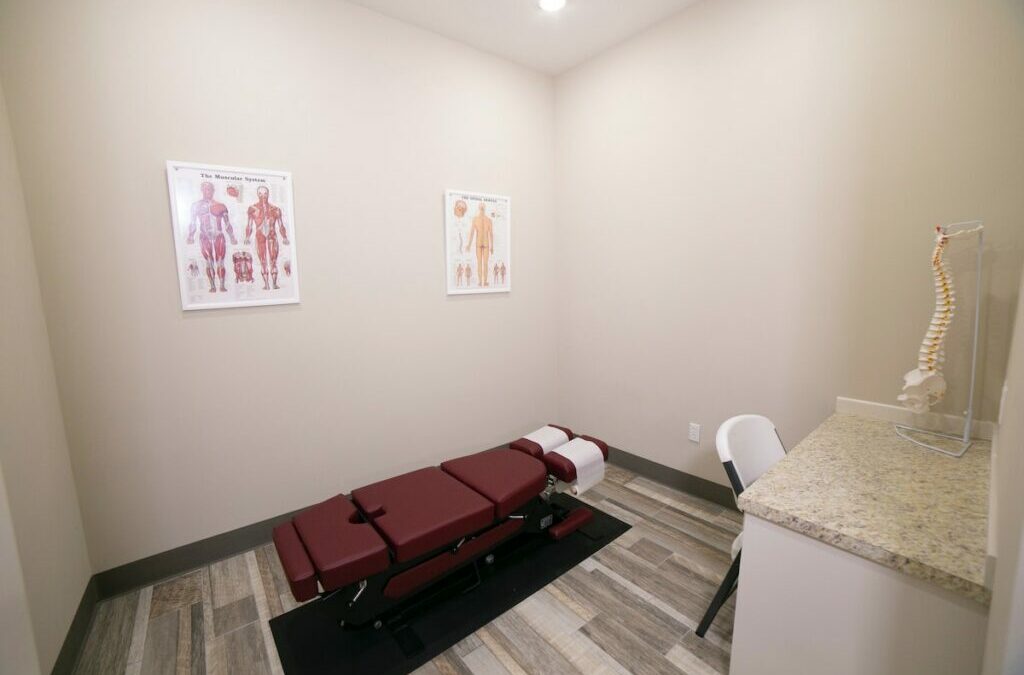
The Impact of Posture on Overall Health: How Chiropractic Can Help
Photo by CHUTTERSNAP on Unsplash
Maintaining good posture is essential for overall health and well-being. Poor posture can lead to various musculoskeletal issues, including back pain, neck discomfort, and reduced mobility. However, the impact of posture on health goes beyond physical discomfort. Posture can affect our mood, energy levels, and even our digestion.
Fortunately, chiropractic care offers a holistic approach to address postural problems and improve alignment. Chiropractors are trained to identify the root cause of postural issues and use non-invasive techniques to correct misalignments. By improving posture, chiropractic care helps enhance spinal health, which can positively impact nervous system function, circulation, and organ function. Additionally, maintaining proper posture can improve breathing, digestion, and overall body mechanics, contributing to better overall health and well-being.
The Importance of Good Posture
Maintaining good posture is essential for overall health and well-being. Poor posture can lead to a variety of health problems, including back pain, headaches, and fatigue. In contrast, good posture can have a positive impact on physical appearance, self-esteem, and confidence.
Effects on Overall Health
Good posture is important for balance and stability, as well as proper alignment of the spine. Poor posture can cause strain on the muscles and joints, leading to pain and discomfort. Over time, this can lead to chronic conditions such as arthritis and degenerative disc disease.
In addition, poor posture can affect the respiratory and digestive systems, leading to breathing difficulties and gastrointestinal problems. By maintaining good posture, you can improve your overall health and prevent a variety of health problems.
Influence on Self-Esteem and Confidence
Good posture can have a positive impact on self-esteem and confidence. When you stand up straight, you appear taller and more confident. This can lead to improved self-esteem and a more positive self-image.
On the other hand, poor posture can make you appear insecure and unsure of yourself. This can lead to feelings of self-doubt and low self-esteem. By maintaining good posture, you can project confidence and improve your overall sense of self-worth.
Impact on Physical Appearance
Good posture can also have a positive impact on physical appearance. When you stand up straight, your body appears more toned and fit. This can lead to a more attractive and youthful appearance.
In contrast, poor posture can make you appear older and less attractive. It can also lead to a variety of physical problems, such as a hunched back and rounded shoulders. By maintaining good posture, you can improve your physical appearance and project a more youthful and attractive image.
In conclusion, good posture is essential for overall health and well-being. It can have a positive impact on physical appearance, self-esteem, and confidence. By maintaining good posture, you can improve your overall health and prevent a variety of health problems.
Understanding Poor Posture
Poor posture is a common problem that affects many people, and it can have a significant impact on overall health. It occurs when the body is not aligned properly, putting strain on muscles, joints, and ligaments. Poor posture can be caused by a variety of factors, including sitting for long periods of time, slouching, carrying heavy bags, and wearing high heels.
Common Causes
One of the most common causes of poor posture is sitting for long periods of time, especially in front of a computer. When sitting, it is easy to slouch or hunch over, putting strain on the neck and back muscles. Carrying heavy bags, such as a backpack or purse, can also cause poor posture, as can wearing high heels, which can throw off the body’s alignment.
Signs and Symptoms
The signs and symptoms of poor posture can vary depending on the severity of the condition. Some of the most common symptoms include back pain, neck pain, headaches, and fatigue. Poor posture can also lead to a hunchback or rounded shoulders, a condition known as kyphosis. Forward head posture, where the head is pushed forward, can also be a sign of poor posture.
Long-Term Effects
If left untreated, poor posture can have long-term effects on overall health. It can lead to chronic back and neck pain, as well as joint pain and stiffness. Poor posture can also cause fatigue and make it difficult to perform daily activities. In severe cases, poor posture can even lead to spinal problems.
Chiropractic care is an effective way to address poor posture and reduce the risk of back pain and other health issues associated with poor posture. A chiropractor can help evaluate your posture, provide guidance on how to maintain good habits, and even perform spinal adjustments to help reduce strain on your muscles and joints.
How Posture Affects Physical Activities
Maintaining good posture is essential for physical activities, as it can greatly impact athletic performance, range of motion, and energy levels. Poor posture can lead to inefficient movement patterns, which can result in decreased performance, increased risk of injury, and reduced energy levels.
Impact on Athletic Performance
Good posture is crucial for optimal athletic performance. Proper alignment of the spine and joints allows for efficient movement patterns, which can lead to improved speed, agility, and power. On the other hand, poor posture can cause muscle imbalances, which can lead to decreased performance and increased risk of injury. For example, hunching forward can limit the ability to take deep breaths, which can negatively affect endurance activities such as running or cycling.
Influence on Range of Motion
Maintaining good posture can also improve range of motion. Proper alignment of the spine and joints allows for greater flexibility and mobility, which can enhance performance and reduce the risk of injury. Poor posture, on the other hand, can limit range of motion and cause stiffness and discomfort. For example, slouching can cause tightness in the chest and shoulders, which can limit the ability to perform overhead movements such as throwing a ball or serving a tennis ball.
Effects on Energy Levels
Posture can also affect energy levels during physical activities. Good posture allows for proper alignment of the spine and joints, which can reduce the amount of energy needed to perform movements. Poor posture, on the other hand, can cause muscle imbalances and inefficient movement patterns, which can lead to increased energy expenditure and fatigue. For example, leaning forward while running can cause the body to work harder to maintain balance, which can lead to increased fatigue and decreased endurance.
In summary, maintaining good posture is crucial for optimal physical performance. Poor posture can lead to decreased athletic performance, limited range of motion, and decreased energy levels. Chiropractic care can be a valuable tool for improving posture and enhancing physical performance.
The Role of Muscles and Joints in Posture
Proper posture is essential for good health and well-being. Poor posture can lead to a variety of health problems, including back pain, neck pain, and headaches. Maintaining good posture requires the proper alignment of the muscles and joints in the body.
Core Muscles
The core muscles of the back, side, pelvis, and buttocks form a sturdy central link between your upper and lower body. Weak core muscles encourage slumping, which tips your body forward and thus off balance. Strong lower leg muscles also help keep you steady when standing. Exercises that strengthen the core muscles can help improve posture and reduce the risk of injury.
Spine and Pelvis
The spine and pelvis are two critical components of good posture. The spine provides support for the upper body, while the pelvis supports the lower body. When the spine and pelvis are properly aligned, the body is in a neutral position, which reduces stress on the muscles and joints. Poor alignment of the spine and pelvis can lead to muscle weakness, joint dysfunction, and pain.
Joints and Flexibility
Joints play a crucial role in maintaining good posture. The joints in the spine, hips, knees, and ankles work together to support the body’s weight and allow for movement. When joints are stiff or restricted, it can lead to poor posture and pain. Maintaining joint flexibility through stretching and exercise can help improve posture and reduce the risk of injury.
In summary, the muscles and joints in the body play a crucial role in maintaining good posture. Weak core muscles, poor alignment of the spine and pelvis, and stiff or restricted joints can all lead to poor posture and pain. However, with proper exercise, stretching, and chiropractic care, it is possible to improve posture and reduce the risk of injury.
Understanding Chiropractic Care
Chiropractic care is a form of alternative medicine that focuses on the diagnosis and treatment of mechanical disorders of the musculoskeletal system, especially the spine. Chiropractors use hands-on spinal manipulation and other alternative treatments to help the body heal itself without the use of drugs or surgery.
Role of Chiropractors
Chiropractors are healthcare professionals who are trained to diagnose and treat musculoskeletal problems. They use a variety of techniques to manipulate the spine and other joints in the body to help relieve pain and improve the function of the nervous system. Chiropractors may also provide advice on lifestyle changes, exercise, and nutrition to help patients maintain good health.
Chiropractic Adjustments
Chiropractic adjustments are the primary treatment method used by chiropractors. These adjustments involve applying controlled force to specific joints in the body to help restore proper joint function and alleviate pain. Chiropractic adjustments may be performed manually or with the use of specialized tools.
Benefits
Chiropractic care can provide a number of benefits to patients. One of the most significant benefits is improved posture. Poor posture can cause a number of health problems, including back pain, headaches, and digestive issues. Chiropractic adjustments can help correct imbalances in the spine and muscles, leading to better posture and improved overall health.
Other benefits of chiropractic care may include:
Reduced pain and inflammation
Improved range of motion
Enhanced immune system function
Better sleep
Increased energy levels
Prevention
Chiropractic care can also be used as a preventative measure to help maintain good health. Regular chiropractic adjustments can help prevent problems before they occur by keeping the spine and other joints in the body functioning properly. Chiropractors may also provide advice on lifestyle changes, exercise, and nutrition to help patients maintain good health and prevent future problems.
In conclusion, chiropractic care is a safe and effective form of alternative medicine that can help improve overall health and well-being. Chiropractors play an important role in diagnosing and treating musculoskeletal problems, and chiropractic adjustments can provide a number of benefits to patients. By maintaining good posture and seeking regular chiropractic care, patients can help prevent future problems and maintain good health.
Chiropractic Techniques for Posture Correction
Chiropractic care is a holistic approach to wellness that focuses on the body’s ability to heal itself without the use of drugs or surgery. One of the primary goals of chiropractic care is to correct spinal misalignments, which can lead to poor posture and a variety of health problems. Here are some of the chiropractic techniques used to correct posture:
Spinal Adjustments
Spinal adjustments, also known as spinal manipulations, are the cornerstone of chiropractic care. During a spinal adjustment, a chiropractor uses their hands or a specialized tool to apply a controlled force to the spine. This force is designed to realign the vertebrae, which can improve posture, reduce pain, and improve overall health.
Stretches and Exercises
Chiropractors may also recommend stretches and exercises to help correct posture. These stretches and exercises are designed to strengthen the muscles that support the spine and improve flexibility. Some common stretches and exercises used in chiropractic care include:
Chin tucks: This exercise involves pulling the chin back towards the neck to improve neck posture.
Shoulder blade squeezes: This exercise involves squeezing the shoulder blades together to improve upper back posture.
Cat-cow stretch: This stretch involves arching and rounding the spine to improve flexibility and posture.
Holistic Approach
Chiropractors take a holistic approach to posture correction, which means they consider the whole person when developing a treatment plan. In addition to spinal adjustments and stretches, chiropractors may also recommend dietary changes, stress reduction techniques, and other lifestyle modifications to improve posture and overall health.
In conclusion, chiropractic care offers a variety of techniques to correct posture and improve overall health. Spinal adjustments, stretches and exercises, and a holistic approach can all be effective in correcting posture and reducing pain. If you are experiencing poor posture or related health problems, consider consulting with a chiropractor to explore your treatment options.
Complementary Therapies
In addition to chiropractic care, there are several complementary therapies that can help improve posture and overall health. These therapies can be used in conjunction with chiropractic care to enhance the benefits of treatment.
Massage Therapy
Massage therapy is a popular complementary therapy that can help improve posture and reduce muscle tension. Massage therapy can help increase blood flow to the muscles, which can help improve their flexibility and reduce the risk of injury. It can also help reduce stress and promote relaxation, which can help improve overall health.
Physical Therapy
Physical therapy is another complementary therapy that can help improve posture and reduce pain. Physical therapy can help improve strength, flexibility, and range of motion, which can help improve posture and reduce the risk of injury. It can also help reduce pain and promote healing, which can help improve overall health.
Yoga
Yoga is a popular complementary therapy that can help improve posture and reduce stress. Yoga involves a series of poses and stretches that can help improve flexibility, strength, and balance. It can also help reduce stress and promote relaxation, which can help improve overall health.
Breathing Exercises
Breathing exercises are another complementary therapy that can help improve posture and reduce stress. Breathing exercises can help improve lung function, reduce stress, and promote relaxation. They can also help improve posture by promoting proper breathing techniques.
Overall, complementary therapies can be a valuable addition to chiropractic care. By combining chiropractic care with complementary therapies like massage therapy, physical therapy, yoga, and breathing exercises, patients can experience a more holistic approach to healthcare that can help improve posture and overall health.
Posture and Specific Conditions
Maintaining good posture is important for overall health, but it becomes even more crucial for people with specific conditions. Here, we discuss how posture can impact pregnancy, arthritis, scoliosis, and chronic pain.
Pregnancy
During pregnancy, a woman’s center of gravity shifts forward, causing her to compensate by leaning back. This can lead to lower back pain and discomfort. Poor posture during pregnancy can also cause unnecessary pressure on the uterus and lead to complications during delivery. Chiropractic care can help alleviate these symptoms by realigning the spine and pelvis, reducing pain and discomfort, and improving overall posture.
Arthritis
Arthritis is a chronic condition that causes inflammation and pain in the joints. Poor posture can exacerbate arthritis symptoms by putting unnecessary pressure on the joints. Chiropractic care can help by improving joint mobility, reducing inflammation, and providing pain management through non-invasive techniques.
Scoliosis
Scoliosis is a condition in which the spine curves to one side, causing uneven shoulders, hips, and waist. Poor posture can worsen scoliosis symptoms and lead to pain and discomfort. Chiropractic care can help by realigning the spine, reducing pain and discomfort, and improving overall posture.
Chronic Pain
Chronic pain can be caused by a variety of factors, including poor posture. Poor posture can put unnecessary strain on the muscles and joints, leading to chronic pain. Chiropractic care can help alleviate chronic pain by realigning the spine, reducing inflammation, and providing pain management through non-invasive techniques.
In conclusion, maintaining good posture is important for overall health, but it becomes even more crucial for people with specific conditions. Chiropractic care can help alleviate symptoms and improve overall posture, leading to a better quality of life.
Conclusion
Maintaining good posture is essential for overall health and well-being. Poor posture can cause a variety of health problems, including back pain, headaches, and breathing difficulties. By improving posture, chiropractic care helps enhance spinal health which can positively impact nervous system function, circulation, and organ function.
Additionally, maintaining proper posture can improve breathing, digestion, and overall body mechanics, contributing to better overall health and well-being. Chiropractic care offers a holistic approach to address postural problems and improve alignment.
Through a combination of adjustments, exercises, and lifestyle modifications, chiropractors can help patients achieve and maintain good posture. It is important to note that chiropractic care is not a substitute for medical care, and patients should always consult with their healthcare provider before starting any new treatment.
Overall, the benefits of chiropractic care on posture are clear. By improving alignment and enhancing spinal health, chiropractic care can help alleviate pain, reduce the risk of future injuries, and improve overall quality of life.






